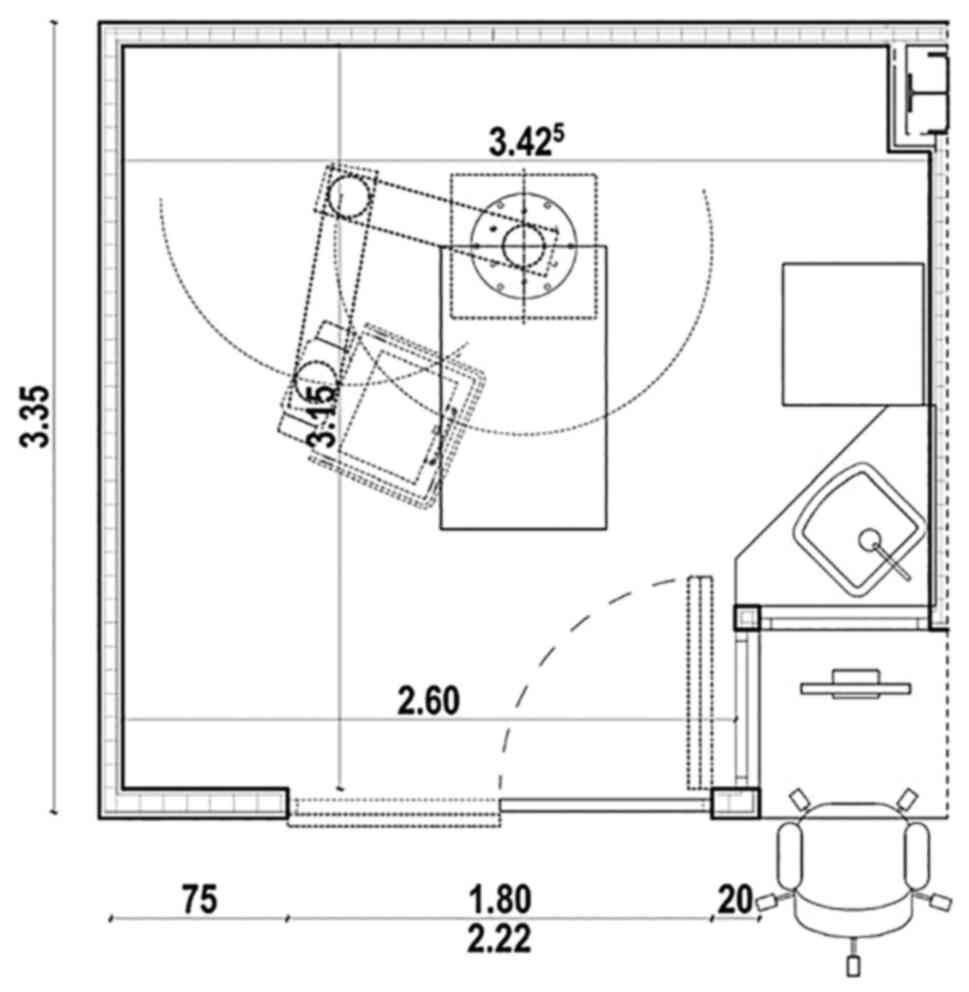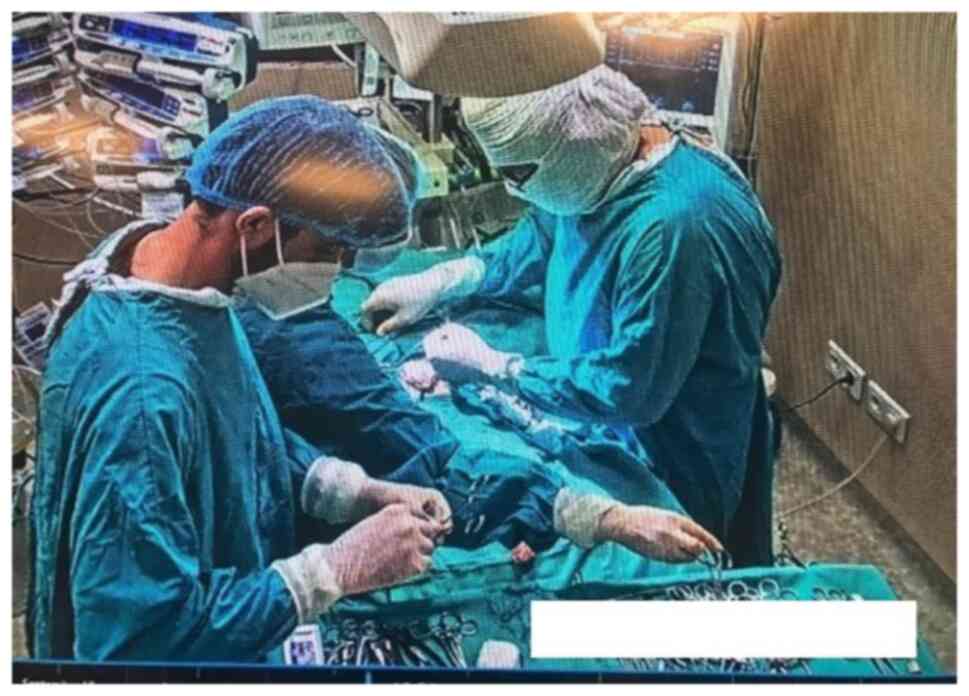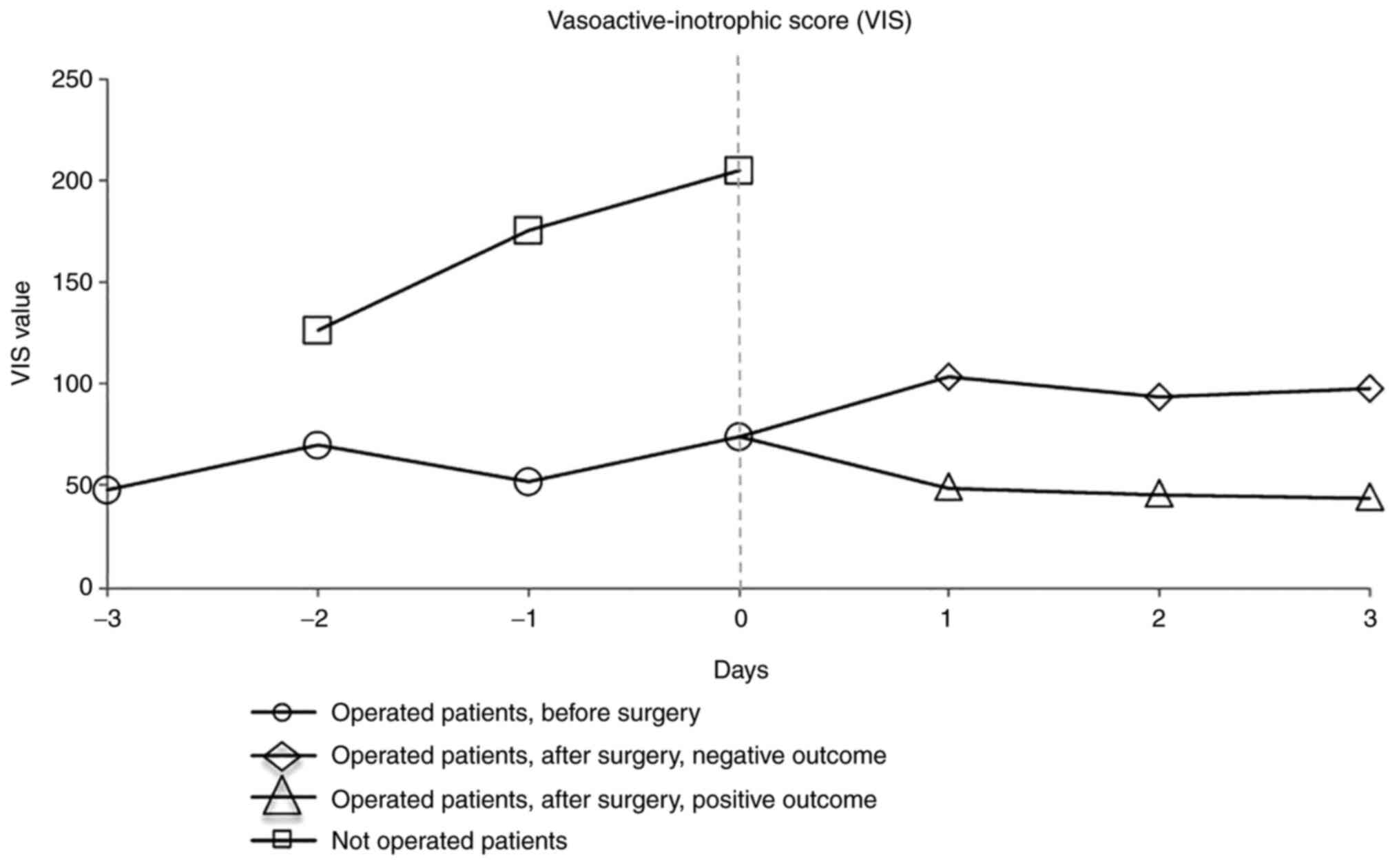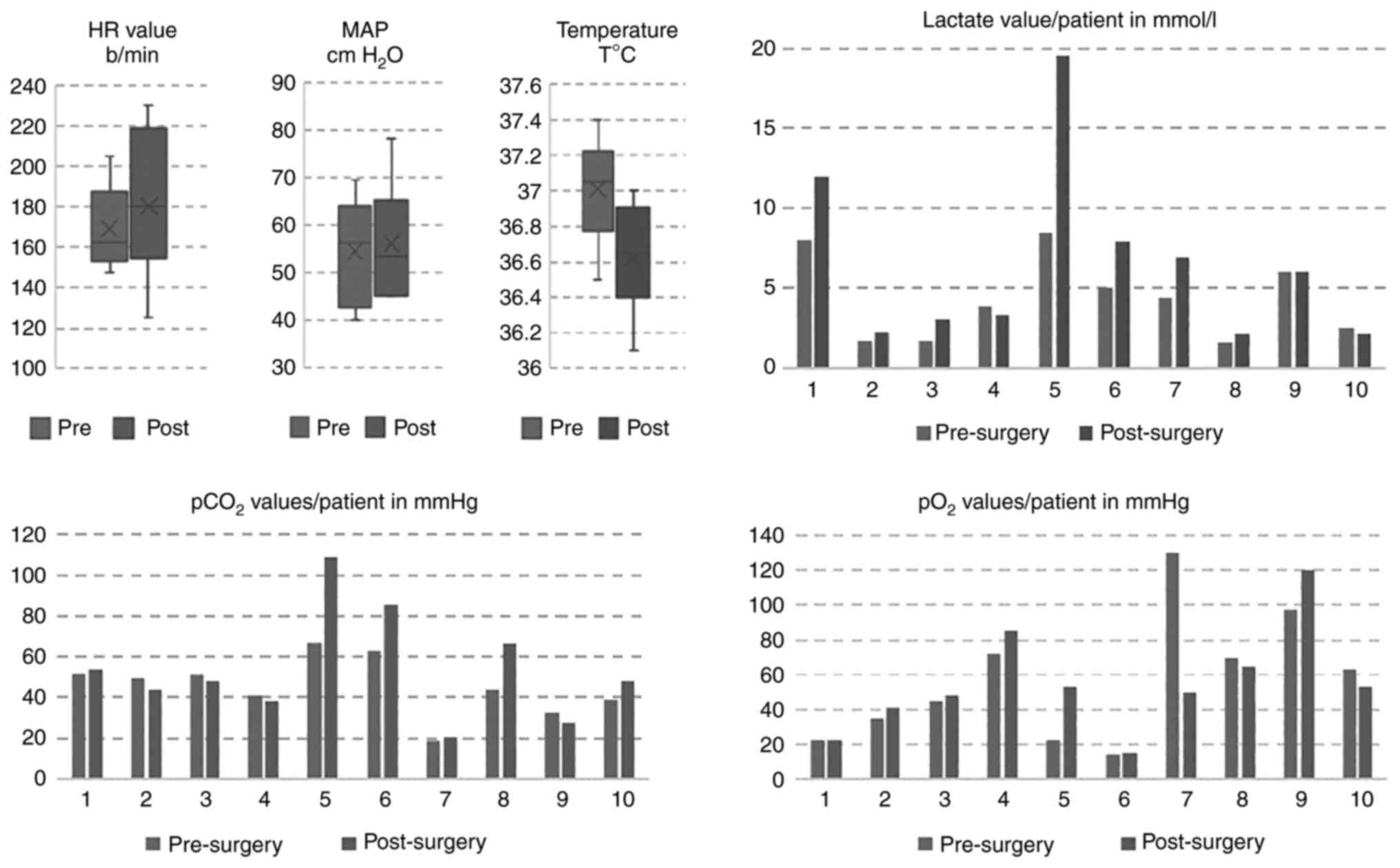|
1
|
Chandrasekharan PK, Rawat M, Madappa R,
Rothstein DH and Lakshminrusimha S: Congenital diaphragmatic
hernia-a review. Matern Health Neonatol Perinatol.
3(6)2017.PubMed/NCBI View Article : Google Scholar
|
|
2
|
Dumitrescu D, Savlovschi C, Borcan R,
Pantu H, Serban D, Gradinaru S, Smarandache G, Trotea T, Branescu
C, Musat L, et al: Clinical case-voluminous diaphragmatic
hernia-surgically acute abdomen: Diagnostic and therapeutical
challenges. Chirurgia (Bucur). 106:657–660. 2011.PubMed/NCBI(In Romanian).
|
|
3
|
McGivern MR, Best KE, Rankin J, Wellesley
D, Greenlees R, Addor MC, Arriola L, de Walle H, Barisic I, Beres
J, et al: Epidemiology of congenital diaphragmatic hernia in
Europe: a register-based study. Arch Dis Child Fetal Neonatal Ed.
100:F137–F144. 2015.PubMed/NCBI View Article : Google Scholar
|
|
4
|
Mallick MS, Jado AM and Al-Bassam AR:
Surgical procedures performed in the neonatal intensive care unit
on critically ill neonates: Feasibility and safety. Ann Saudi Med.
28:105–108. 2008.PubMed/NCBI View Article : Google Scholar
|
|
5
|
Fanning NF, Casey W and Corbally MT:
In-situ emergency paediatric surgery in the intensive care unit.
Pediatr Surg Int. 13:587–589. 1998.PubMed/NCBI View Article : Google Scholar
|
|
6
|
Beckmann U, Gillies DM, Berenholtz SM, Wu
AW and Pronovost P: Incidents relating to the intra-hospital
transfer of critically ill patients. An analysis of the reports
submitted to the Australian incident monitoring study in intensive
care. Intensive Care Med. 30:1579–1585. 2004.PubMed/NCBI View Article : Google Scholar
|
|
7
|
Serban D, Socea B, Badiu CD, Tudor C,
Balasescu SA, Dumitrescu D, Trotea AM, Spataru RI, Vancea G,
Dascalu AM and Tanasescu C: Acute surgical abdomen during the
COVID-19 pandemic: Clinical and therapeutic challenges. Exp Ther
Med. 21(519)2021.PubMed/NCBI View Article : Google Scholar
|
|
8
|
Snoek KG, Reiss IK, Greenough A, Capolupo
I, Urlesberger B, Wessel L, Storme L, Deprest J, Schaible T, van
Heijst A, et al: CDH EURO Consortium. Standardized postnatal
management of infants with congenital diaphragmatic hernia in
Europe: The CDH EURO Consortium Consensus-2015 Update. Neonatology.
110:66–74. 2016.PubMed/NCBI View Article : Google Scholar
|
|
9
|
Partridge EA, Hanna BD, Rintoul NE,
Herkert L, Flake AW and Adzick NS: Partrige, Brain-type natriuretic
peptide levels correlate with pulmonary hypertension and
requirement for extracorporeal membrane oxygenation in congenital
diaphragmatic hernia. J Pediatr Surg. 50:263–266. 2015.PubMed/NCBI View Article : Google Scholar
|
|
10
|
Steurer MA, Moon-Grady AJ, Fineman JR, Sun
CE, Lusk LA, Wai KC and Keller RL: B-type natriuretic peptide:
Prognostic marker in congenital diaphragmatic hernia. Pediatr Res.
76:549–554. 2014.PubMed/NCBI View Article : Google Scholar
|
|
11
|
Heindel K, Holdenrieder S, Patel N,
Bartmann P, Schroeder L, Berg C, Merz WM, Mueller A and Kipfmueller
F: Early postnatal changes of circulating N-terminal-pro-B-type
natriuretic peptide in neonates with congenital diaphragmatic
hernia. Early Hum Dev. 146(105049)2020.PubMed/NCBI View Article : Google Scholar
|
|
12
|
Davidson J, Tong S, Hancock H, Hauck A, da
Cruz E and Kaufman J: Prospective validation of the
vasoactive-inotropic score and correlation to short-term outcomes
in neonates and infants after cardiothoracic surgery. Intensive
Care Med. 38:1184–1190. 2012.PubMed/NCBI View Article : Google Scholar
|
|
13
|
Boyer TJ and Kritzmire SM: Neonatal
Anesthesia. In: StatPearls [Internet]. StatPearls Publishing,
Treasure Island, FL, 2021.
|
|
14
|
Yang EY, Allmendinger N, Johnson SM, Chen
C, Wilson JM and Fishman SJ: Neonatal thoracoscopic repair of
congenital diaphragmatic hernia: Selection criteria for successful
outcome. J Pediatr Surg. 40:1369–1375. 2005.PubMed/NCBI View Article : Google Scholar
|
|
15
|
Gaies MG, Jeffries HE, Niebler RA,
Pasquali SK, Donohue JE, Yu S, Gall C, Rice TB and Thiagarajan RR:
Vasoactive-inotropic score is associated with outcome after infant
cardiac surgery: An analysis from the Pediatric Cardiac Critical
Care Consortium and Virtual PICU System Registries. Pediatr Crit
Care Med. 15:529–537. 2014.PubMed/NCBI View Article : Google Scholar
|
|
16
|
Dilli D, Akduman H, Orun UA, Tasar M,
Tasoglu I, Aydogan S, Citli R and Tak S: Predictive value of
vasoactive-inotropic score for mortality in newborns undergoing
cardiac surgery. Indian Pediatr. 56:735–740. 2019.PubMed/NCBI
|
|
17
|
McIntosh AM, Tong S, Deakyne SJ, Davidson
JA and Scott HF: Validation of the Vasoactive-inotropic score in
pediatric sepsis. Pediatr Crit Care Med. 18:750–757.
2017.PubMed/NCBI View Article : Google Scholar
|
|
18
|
Duess JW, Zani-Ruttenstock EM, Garriboli
M, Puri P, Pierro A and Hoellwarth ME: Outcome of right-sided
diaphragmatic hernia repair: A multicentre study. Pediatr Surg Int.
31:465–471. 2015.PubMed/NCBI View Article : Google Scholar
|
|
19
|
Le LD, Keswani SG, Biesiada J, Lim FY,
Kingma PS, Haberman BE, Frischer J, Habli M and Crombleholme TM:
The congenital diaphragmatic hernia composite prognostic index
correlates with survival in left-sided congenital diaphragmatic
hernia. J Pediatr Surg. 47:57–62. 2012.PubMed/NCBI View Article : Google Scholar
|
|
20
|
Mullassery D, Ba'ath ME, Jesudason EC and
Losty PD: Value of liver herniation in prediction of outcome in
fetal congenital diaphragmatic hernia: A systematic review and
meta-analysis. Ultrasound Obstet Gynecol. 35:609–614.
2010.PubMed/NCBI View
Article : Google Scholar
|
|
21
|
Collot V, Malinverni S, Haltout J,
Schweitzer E, Mols P and Bartiaux M: Agreement between arterial and
capillary pH, pCO2 and lactate in patients in the
emergency department. Emerg Med Int. 2021(7820041)2021.PubMed/NCBI View Article : Google Scholar
|
|
22
|
Omer M, Melo AM, Kelly L, Mac Dermott EJ,
Leahy TR, Killeen O, Saugstad OD, Savani RC and Molloy EJ: Emerging
Role of the NLRP3 inflammasome and interleukin-1β in neonates.
Neonatology. 117:545–554. 2020.PubMed/NCBI View Article : Google Scholar
|
|
23
|
Suceveanu AI, Mazilu L, Katsiki N, Parepa
I, Voinea F, Pantea-Stoian A, Rizzo M, Botea F, Herlea V, Serban D
and Suceveanu AP: NLRP3 Inflammasome Biomarker-Could Be the new
tool for improved cardiometabolic syndrome outcome. Metabolites.
10(448)2020.PubMed/NCBI View Article : Google Scholar
|
|
24
|
Liao J, Kapadia VS, Brown LS, Cheong N,
Longoria C, Mija D, Ramgopal M, Mirpuri J, McCurnin DC and Savani
RC: The NLRP3 inflammasome is critically involved in the
development of bronchopulmonary dysplasia. Nat Commun.
6(8977)2015.PubMed/NCBI View Article : Google Scholar
|
|
25
|
Hall NJ, Stanton MP, Kitteringham LJ,
Wheeler RA, Griffiths DM, Drewett M and Burge DM: Scope and
feasibility of operating on the neonatal intensive care unit: 312
cases in 10 years. Pediatr Surg Int. 28:1001–1005. 2012.PubMed/NCBI View Article : Google Scholar
|
|
26
|
Pelizzo G, Bagolan P, Morini F, Aceti M,
Alberti D, Andermarcher M, Avolio L, Bartoli F, Briganti V,
Cacciaguerra S, et al: Bedside surgery in the newborn infants:
Survey of the Italian society of pediatric surgery. Ital J Pediatr.
46(134)2020.PubMed/NCBI View Article : Google Scholar
|
|
27
|
Kumar Sinha S and Neogi S: Bedside
neonatal intensive care unit surgery-myth or reality! J Neonatal
Surg. 2(20)2013.PubMed/NCBI
|
|
28
|
Wang YL, Jeng SF, Tsao PN, Chou HC, Chen
CY and Hsieh WS: Operating room within the neonatal intensive care
unit-experience of a medical Center in Taiwan. Pediatr Neonatol.
56:220–225. 2015.PubMed/NCBI View Article : Google Scholar
|
|
29
|
He ZR, Lin TI, Ko PJ, Tey SL, Yeh ML, Wu
HY, Wu CY, Yang YSH, Yang SN and Yang YN: The beneficial effect of
air cleanliness with ISO 14644-1 class 7 for surgical intervention
in a neonatal intensive care unit: A 10-year experience. Medicine
(Baltimore). 97(e12257)2018.PubMed/NCBI View Article : Google Scholar
|
|
30
|
Kardon G, Ackerman KG, McCulley DJ, Shen
Y, Wynn J, Shang L, Bogenschutz E, Sun X and Chung WK: Congenital
diaphragmatic hernias: from genes to mechanisms to therapies. Dis
Model Mech. 10:955–970. 2017.PubMed/NCBI View Article : Google Scholar
|
|
31
|
Okuyama H, Usui N, Hayakawa M and Taguchi
T: Japanese CDH study group. Appropriate timing of surgery for
neonates with congenital diaphragmatic hernia: Early or delayed
repair? Pediatr Surg Int. 33:133–138. 2017.PubMed/NCBI View Article : Google Scholar
|


















